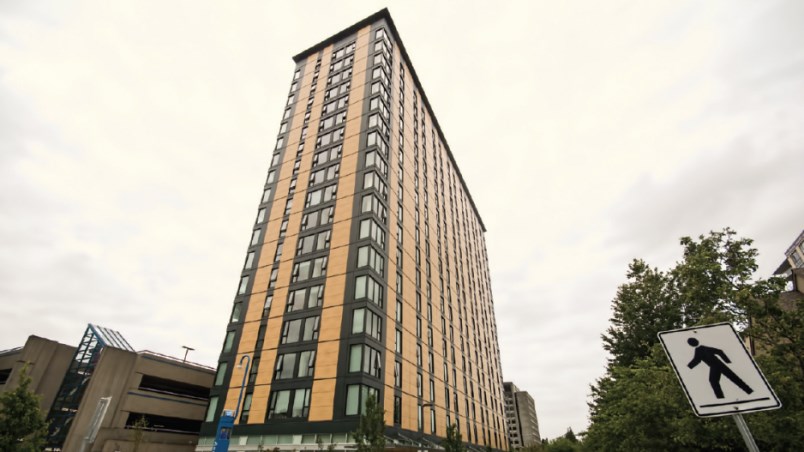A new building form that could bridge the gap between the six-storey apartment and the 25-storey highrise could be popping up in the Coquitlam skyline a little sooner than expected.
The city is looking into becoming an early adopter of building code changes that would clear the way to allowing mass-timber construction of buildings up to 12 storeys, exceeding the current six-storey height limit for wood-frame structures.
“We are quite keen on it,” said Jim McIntyre, Coquitlam’s general manager of planning and development, during a council-in-committee meeting last month. “It is leading-edge technology and as a building process it is quite unique.”
Mass timber buildings, in which the primary load-bearing structures are made of solid or engineered wood, is seen by the provincial government as a way of giving the B.C. lumber industry a needed shot in the arm.
But the building code changes will also have ramifications for local governments.
For example, residents often ask city officials why developers cannot build more 10- to 12-storey buildings instead of the 25-storey and up highrises that make up many of the new residential construction projects in Coquitlam. The answer generally comes down to economics, according to McIntyre.
He told The Tri-City News that once a builder sets up a site for concrete construction, the developers tend to want to build higher to cover the increased costs. While 12-storey concrete buildings do exist in parts of Coal Harbour and along the Cambie corridor in Vancouver, he said it is harder to make the numbers work in places like Coquitlam.
“In suburban markets, they want to get the towers up to a certain level,” he said. “That is why this [mass-timber] building form is kind of intriguing.”
Because the city regulates mid-rise zones by floor-area ratio rather than building height, McIntyre said re-opening some of the city’s neighbourhood plans will not likely be necessary when the new building code changes arrive.
Still, he said planners may revisit some of the transition areas — neighbourhoods lying between higher-density, transit-oriented development and areas predominantly made up of detached homes — to see what the new building form would look like on the ground.
“We may want to go through and do that evaluation,” he said, later adding: “It will be interesting to see how the development community responds.”
The addition of 12-storey mass-timber buildings is already being considered in changes to the national building code, which is expected to be drafted next year. But B.C. is still a few years away from adopting the regulatory changes, which could take place as late as 2022.
In the meantime, McIntyre said the province is encouraging some communities to become early adopters of the new code, which permit mass-timber construction on certain designated properties on a pilot-project basis.
“[The province] would set up a unique building code for a particular site,” he said during the committee meeting. “That is the sort of initiative we’d be getting into.”
FIRE SAFETY
One of the biggest concerns facing taller buildings made of wood is the fire hazard.
But Doug Vance, Coquitlam’s manager of building permits, said mass-timber projects would be required to have more robust sprinkler protection systems than standard concrete structures.
Most of the wood would be encapsulated in fire-resistant gypsum, he added, noting that mass timber does not have the same burning characteristics as standard wood-frame buildings.
“It chars on the outside as opposed to burning through,” he said, noting that materials make fire slow to spread.
Taller wood structures have already started to crop up in other parts of the Lower Mainland. The 18-storey Brock Commons tower at UBC was the tallest wood building in the world when it was completed in 2017 and developer Perkins+Will is proposing a 30- to 40-storey mixed-use wood tower along Vancouver's Broadway corridor.
– with files from Business In Vancouver



